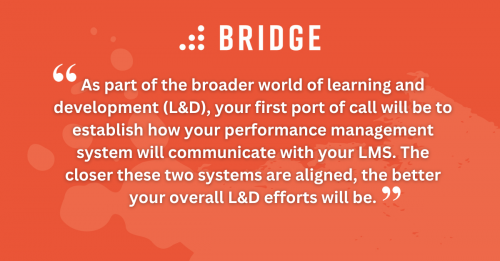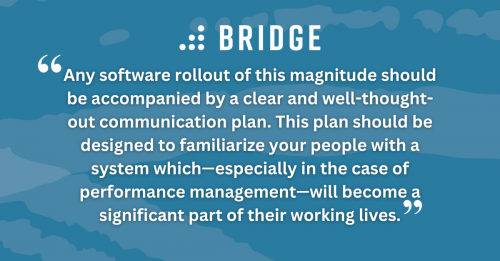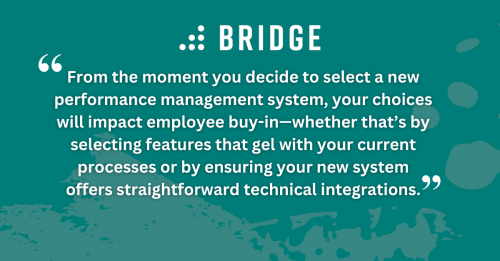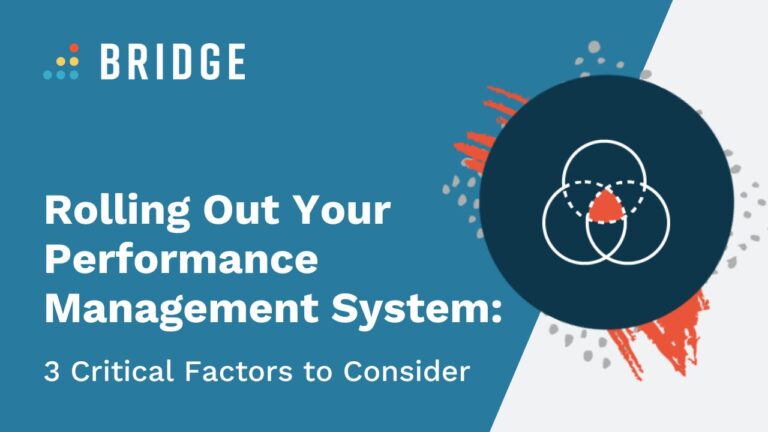When you’ve put care and attention into selecting the right performance management system, you’ll have all the more reason to ensure that it’s properly implemented.
It’s easy to assume that implementing software is a purely technical exercise that sits solely in the hands of your IT department. In practice, though IT absolutely has a part to play, there are three equally important threads to bear in mind when you’re rolling out your performance management system:
- Integration
- Communication
- Adoption
Here at Bridge, we’re no strangers to these three pillars of performance management system integration—so let’s dive in!

Think About Synergies and Integrations
Although rolling out a new system isn’t just an IT process, you’ll definitely want to talk to your IT team before making any major decisions.
It’s especially important to get your IT department’s guidance on how your shiny new performance platform will interact with the other systems that form your organization’s infrastructure.
As part of the broader world of learning and development (L&D), your first port of call will be to establish how your performance management system will communicate with your LMS. The closer these two systems are aligned, the better your overall L&D efforts will be, as your performance and learning data mutually inform one another to generate a comprehensive overview of employee progress.
There’s more to it than L&D, however. You’ll also want to make sure your new performance management system can integrate with your Human Resources Information System (HRIS), and potentially with a whole host of third-party applications.

Put Together a Communication Plan
The technical side of implementation may be vital, but if your employees don’t know that a new system has been introduced, the hard work of your IT department might feel a tiny bit less impactful!
That’s why any software rollout of this magnitude should be accompanied by a clear and well-thought-out communication plan. This plan should be designed to familiarize your people with a system which—especially in the case of performance management—will become a significant part of their working lives.
A good communication plan will include considerations like:
- An initial announcement to your workforce revealing that a new performance management system is on its way
- Training programs for managers and employees to ensure that your people can use the new system once it’s in place
- A clear timeframe outlining when your people should begin to use your new system—whether that’s to arrange 1:1 meetings, set goals, or engage with any other feature that your organization needs to embrace
By creating a communication plan along these lines, you’ll achieve more than just helping your people with the practicalities surrounding a new system. You’ll also clearly establish that your new performance platform isn’t a fun novelty or a brief experiment, but a new way of life at your organization.
KEEP READING | ‘How to Create a Successful Sales Onboarding Strategy’
Encourage Employee and Manager Adoption
Communicating your expectations for how your employees use your new system is the first step toward securing full adoption.
As with any large-scale software solution, adoption could be the single biggest hurdle you’ll need to overcome in your performance platform’s implementation process. In fact, every aspect of investing in a new performance solution, from choosing the right option to training managers and establishing timeframes, can all be understood as different methods for ensuring that your people actually adopt the system you’ve invested in.
There’s no question that tech adoption is a tough nut to crack. It’s telling that, in a study conducted by EY, just 20% of large businesses were able to realize the full benefits of their digital change plans. EY rightly attributes this low figure to a lack of consideration for the employees who’ll actually be using any new technology involved in digital change.
There are plenty of tried-and-tested strategies for bolstering your adoption rates. You can, for example, make the adoption process more seamless by appointing an executive sponsor: a senior member of your organization who drives adoption by leading from the top and acting as a model user of your performance management system.

Bonus Tip: Choose the Right Performance Management System
No matter how many digital champions you appoint, however, the most important factor for encouraging adoption will always be your chosen performance management system. After all, the right system will make it easy for your people to do what they need it to do.
This philosophy encompasses every aspect of your performance management investment process. From the moment you decide to select a new performance management system, your choices will impact employee buy-in, whether that’s by selecting features that gel with your current processes or by ensuring your new system offers straightforward technical integrations.
By putting these factors together, you’ll find your people far more inclined to incorporate your performance management system into their working lives—and far more able to reach new heights of professional development as a result.
UNCOVER MORE PERFORMANCE INSIGHTS | ‘Rethinking the 9 Box Talent Review’
Discover the Ins and Outs of Performance Management Systems
Bridge Performance Management
Bridge gives organizations the power to engage and develop their people through its performance management platform. In one unified experience, align goals, identify top performers, fill skill gaps, build a culture of continuous feedback, and make informed talent decisions. The platform offers performance reviews, 1on1 agendas, development plans, skills feedback and talent reviews. Bridge has helped organizations build consistency and alignment when it comes to employee development and growth.
Download our full ebook on performance management systems for a complete overview of the benefits and selection tips that go into a successful performance platform integration. And if you want to know more about the array of workflow applications and HRISs that Bridge integrates with—alongside the other factors that make Bridge’s performance management system the perfect solution for a straightforward rollout—just ask for a demo.




